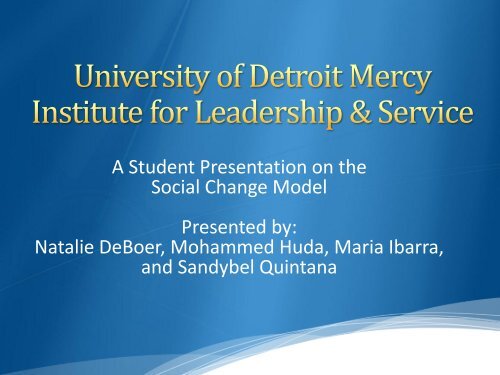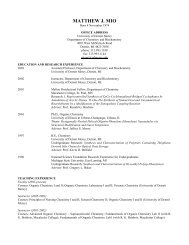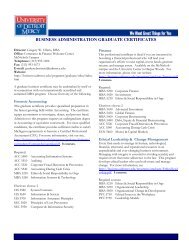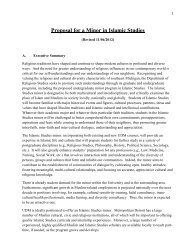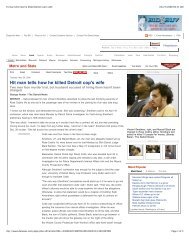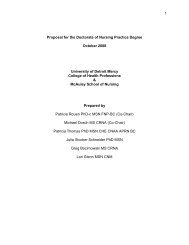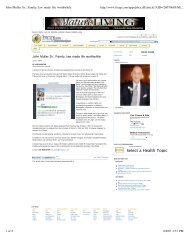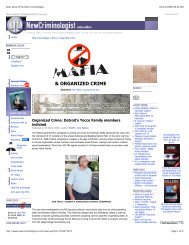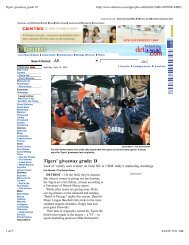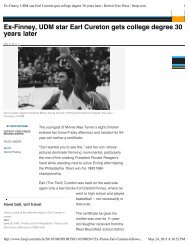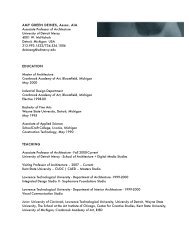The Institute for Leadership and Service Conceptual Model
The Institute for Leadership and Service Conceptual Model
The Institute for Leadership and Service Conceptual Model
Create successful ePaper yourself
Turn your PDF publications into a flip-book with our unique Google optimized e-Paper software.
A Student Presentation on the<br />
Social Change <strong>Model</strong><br />
Presented by:<br />
Natalie DeBoer, Mohammed Huda, Maria Ibarra,<br />
<strong>and</strong> S<strong>and</strong>ybel Quintana
Individual<br />
<strong>Leadership</strong> Values<br />
Self Awareness &<br />
Reflection: Underst<strong>and</strong>ing<br />
ones talents, beliefs, values,<br />
emotions, <strong>and</strong> attitudes that<br />
allow one to appreciate <strong>and</strong><br />
underst<strong>and</strong> different leadership<br />
styles <strong>and</strong> take action.<br />
Character <strong>and</strong> Integrity: Ability<br />
to make ethical decisions based on<br />
values, personal <strong>and</strong> communal, <strong>and</strong> act<br />
with honesty <strong>and</strong> consistency.<br />
Compassion Through<br />
<strong>Service</strong>: Commitment to serve<br />
toward a common purpose. Value,<br />
passion, <strong>and</strong> intensity in help, as<br />
well as an underst<strong>and</strong>ing in the<br />
needs of others.<br />
<strong>The</strong><br />
<strong>Institute</strong>’s<br />
Mission<br />
<strong>The</strong> <strong>Institute</strong> <strong>for</strong> <strong>Leadership</strong> <strong>and</strong> <strong>Service</strong> <strong>Conceptual</strong> <strong>Model</strong><br />
Group<br />
<strong>Leadership</strong><br />
Values<br />
Common Purpose: Ability to<br />
work together with others toward a<br />
shared goal. An underst<strong>and</strong>ing that<br />
a shared vision is important to the<br />
group.<br />
Developing Relationships: Uniting<br />
with other group members through trust,<br />
built by shared values, <strong>and</strong> common goals <strong>for</strong><br />
the group. Learning to work side by side <strong>and</strong><br />
build strong ties with others.<br />
Team Building Through<br />
<strong>Service</strong>: Working <strong>for</strong> others<br />
through a common purpose while<br />
developing strong relationships<br />
throughout the group.<br />
Underst<strong>and</strong>ing ways to build<br />
strength within the group.<br />
Community <strong>Leadership</strong><br />
Values<br />
Common Good <strong>and</strong> Social<br />
Justice: Belief in community<br />
values. Doing what is right <strong>and</strong> just not<br />
<strong>for</strong> self, but <strong>for</strong> the entire community.<br />
Engagement with Diverse<br />
Communities: Ability to work along<br />
side <strong>and</strong> appreciate people of diverse<br />
backgrounds, ethical, religious, racial,<br />
etc.; show empathy <strong>for</strong> others, while<br />
engaging the community in activities <strong>and</strong><br />
decisions.<br />
Social Change through<br />
<strong>Service</strong>: Using one’s abilities<br />
to create good <strong>for</strong> others.<br />
Recognizing those in need while<br />
willing to be the change <strong>for</strong> the<br />
better through actions in the<br />
community.<br />
<strong>The</strong> University of Detroit Mercy's <strong>Institute</strong> <strong>for</strong> <strong>Leadership</strong> <strong>and</strong> <strong>Service</strong> provides opportunities <strong>for</strong> all members of the UDM<br />
community to engage in social change <strong>for</strong> the common good. <strong>The</strong> <strong>Institute</strong> upholds the ideals of our founders who believe in<br />
the promotion of justice <strong>and</strong> compassionate service to those in need as we are Trans<strong>for</strong>ming Lives to Lead <strong>and</strong> Serve.<br />
Adapted from: “Astin, A. H.; A Social Change <strong>Model</strong> of <strong>Leadership</strong> Development Guidebook, Version III, National Clearinghouse <strong>for</strong> <strong>Leadership</strong> Programs, 1996”
<strong>The</strong> model makes it easier to underst<strong>and</strong> the<br />
mission of the university.<br />
“<strong>The</strong> University of Detroit Mercy, a Catholic<br />
university in the Jesuit <strong>and</strong> Mercy traditions,<br />
exists to provide excellent, student-centered,<br />
undergraduate <strong>and</strong> graduate education in an<br />
urban context. A UDM education seeks to<br />
integrate the intellectual, spiritual, ethical,<br />
<strong>and</strong> social development of our students.”
<strong>The</strong> first phase is the individual leadership<br />
phase.<br />
This takes place during a students first year.<br />
This is where most students are introduced to<br />
service learning.
Self- Awareness & Reflection<br />
Self- Awareness is the ability to recognize that<br />
there is a problem in the community in which<br />
you are serving.<br />
Reflection is the process of trying to underst<strong>and</strong><br />
the problem <strong>and</strong> what you can do to help.
Character- is the morals <strong>and</strong> the values of a<br />
person.<br />
Integrity- is a characteristic of someone that<br />
consistently follows their morals <strong>and</strong> values.
Compassion Through <strong>Service</strong>- a commitment to<br />
serve people <strong>and</strong> be as underst<strong>and</strong>ing to their<br />
needs as possible.
WORKING WITH JONAS<br />
SALK ELEMENTARY<br />
SCHOOL
Group leadership is the second phase in the<br />
Social Change <strong>Model</strong>.<br />
This begins in the students second <strong>and</strong> third<br />
year here at the university.<br />
Through a person’s experiences in individual<br />
leadership, they transition through group<br />
leadership.
Common Purpose<br />
Developing Relationships<br />
Team Building Through <strong>Service</strong>
Shared Vision<br />
Aims <strong>and</strong> Values<br />
Working with others
Controversy with Civility “Differences in view point are<br />
inevitable <strong>and</strong> valuable <strong>and</strong>, second, that such<br />
differences must be aired openly with respect <strong>and</strong><br />
courtesy” (Astin p.6)<br />
• To enhance our ability to work with others.<br />
• Question: What are some things you can<br />
personally do in a group setting that would<br />
enable each group member to bring their full<br />
self (talent, perspectives, <strong>and</strong> identities) to the<br />
conversation?
Building <strong>and</strong> Sustaining Trust<br />
Sharing Ownership<br />
Celebrating Success<br />
Controversy with Civility
Collaboration: In order to have team building<br />
through service a collaboration is necessary.<br />
“Working together toward common goals by<br />
sharing responsibility, authority, <strong>and</strong><br />
accountability in achieving this goals.”<br />
(Komives <strong>and</strong> Wagner p.196 )
Community <strong>Leadership</strong> is the third stage of the<br />
Social Change <strong>Model</strong>.<br />
<strong>The</strong> ultimate goal of <strong>The</strong> university’s mission.<br />
<strong>The</strong> peak of <strong>Leadership</strong> influence.<br />
Has most wide spreading affect due being<br />
engaged with multiple parties.
Common Good & Social Justice-<br />
Doing what is right <strong>for</strong> the<br />
community not just yourself.
Engagement with Diverse Communities-<br />
Working with others from all backgrounds <strong>and</strong><br />
engaging with others to make decisions<br />
concerning the community.
Social Change through <strong>Service</strong>-<br />
Doing good <strong>for</strong> others through<br />
your own actions in order to make<br />
the community you live in a better<br />
place.
Teach<br />
Reach<br />
Feed<br />
Lead<br />
• Educate students about hunger issues.<br />
• Create awareness about the issues in the community.<br />
• Reach out to hungry individuals in the community.<br />
• Gather food <strong>and</strong> supplies to be able to feed those in the community.<br />
• <strong>The</strong> next is to take the lead <strong>and</strong> serve the food to the community.<br />
• Passing on the in<strong>for</strong>mation to the next set of students is also important.
Pushing <strong>for</strong> a DREAM
Program started by this year’s Jesuit Volunteer<br />
Kelly Miguens.<br />
It was started to raise awareness about the<br />
DREAM Act <strong>and</strong> the need <strong>for</strong> immigration<br />
re<strong>for</strong>m.<br />
It works by physically doing push-ups as a way<br />
to represent the hardships undocumented<br />
students face.
Pushing <strong>for</strong> a DREAM began by:<br />
Being self aware of the problem.<br />
Empathy through <strong>Service</strong><br />
Ignatian Family Teach-In
Pushing <strong>for</strong> A DREAM extended to eight JVC<br />
members in Detroit.<br />
From there it exp<strong>and</strong>ed to the UDM Community<br />
in the Ministry office.
From UDM the project exp<strong>and</strong>ed to the rest of<br />
the JVC Midwest Regions:<br />
Chicago Clevel<strong>and</strong> Milwaukee<br />
Nashville<br />
Kansas<br />
City<br />
St. Louis
16 people per<br />
community<br />
65,000<br />
undocumented<br />
students<br />
581 push-ups<br />
Multiplied<br />
by 7 cities<br />
Divided by<br />
112 people<br />
Divided by<br />
31<br />
112 total<br />
people<br />
581 pushups<br />
per<br />
person<br />
19 push-ups<br />
a day
Portl<strong>and</strong> Maine DC<br />
Cali<strong>for</strong>nia Philadelphia Paraguay
<strong>The</strong> Social Change <strong>Model</strong> is founded on<br />
relationships <strong>and</strong> collaboration.<br />
Shared responsibility <strong>and</strong> accountability count as<br />
much as service.
• Serving on your own<br />
• Learning about<br />
yourself<br />
Leads to<br />
Leads to<br />
• Working with a<br />
group.<br />
• Learning about<br />
others<br />
• Helping the<br />
community.<br />
• Exp<strong>and</strong>ing beyond<br />
<strong>and</strong> spreading<br />
awareness.<br />
Equals the Social<br />
Change <strong>Model</strong>


